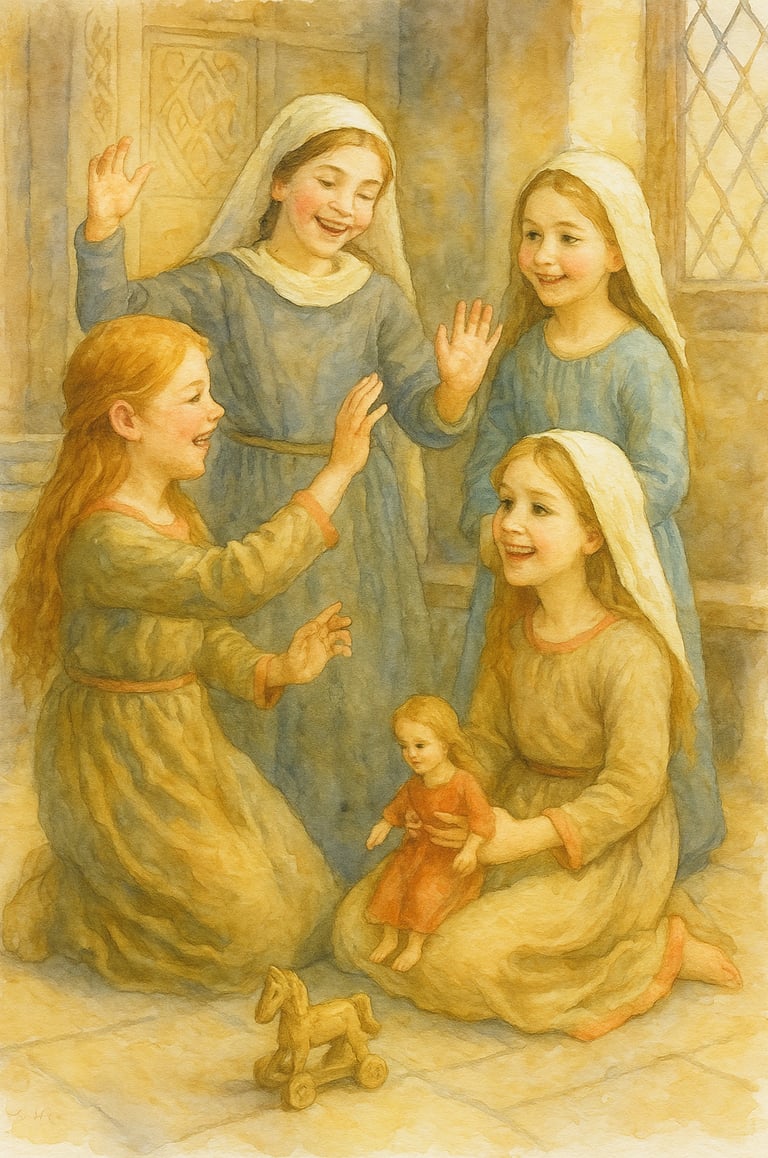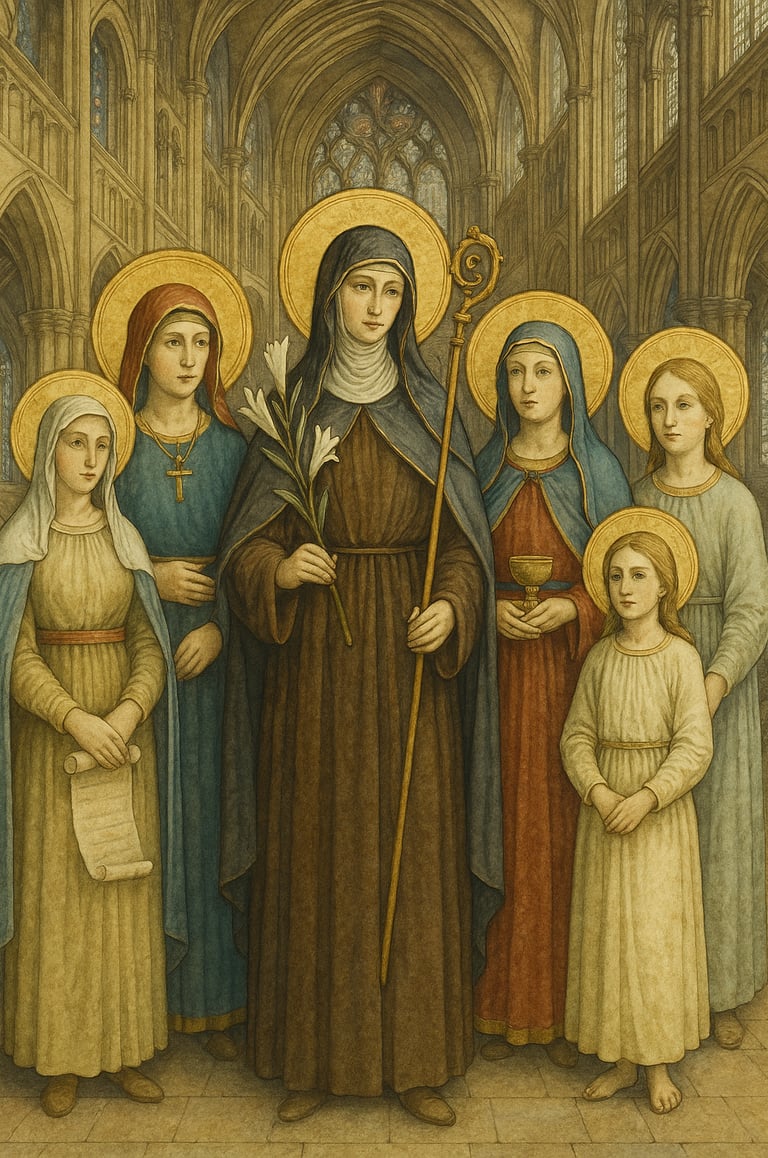St. Ethelreda and the House of Saints
A Legacy of Holy Womanhood
Halo & Light Studios
6/24/20254 min read


Click Link for a reel of Daily Dose of Saints and Faithful Art:
https://youtube.com/shorts/w1U2-t2w42k?feature=share
In the mid-7th century, England was not yet a united nation. Pagan tribes lingered in various regions, and Christianity was still taking root through missionary labor and royal conversion. Amid this fragile soil, a remarkable royal household in East Anglia produced a dynasty of holy women—saints who would shape the Church in its infancy and sanctify the land through prayer, leadership, and sacrifice.
Today, we celebrate St. Etheldreda (also known as Æthelthryth or St. Audrey), a princess born to King Anna of East Anglia and Queen Sæwara in a Suffolk village. Raised in a devout Christian court, Etheldreda longed from an early age to consecrate her life entirely to God. Yet, as an obedient royal daughter, she first entered into marriage with Prince Tonbert, who died three years later. After five years of contemplative solitude on the Isle of Ely, she was married again—this time to King Ecgfrith of Northumbria, with whom she remained for twelve years.
Remarkably, both marriages were unconsummated. Etheldreda had taken a vow of virginity and kept it with firm resolve. With her husband’s reluctant blessing, she left courtly life in 673 A.D. to found a double monastery on the Isle of Ely.
She died in 679, and sixteen years later her body was found miraculously incorrupt—a sign of divine favor and a powerful witness to her sanctity. Her incorrupt body remained at Ely until the Protestant Reformation, when it was destroyed during iconoclastic uprisings. Her feast is celebrated on June 23, and Ely remained for centuries a thriving center of Catholic devotion and pilgrimage.
Etheldreda lived in a time when the Church in England was still forming its identity—shaped by Roman missionaries like St. Augustine of Canterbury and enriched by the Celtic tradition. Monasticism—a way of life in which individuals consecrate themselves entirely to God through prayer, asceticism, and communal or solitary religious devotion—formed the spiritual backbone of Christian life, especially for noble women who were often called to found religious communities, educate others, and serve as spiritual mothers.
Etheldreda’s family embraced this call with extraordinary faith. Her sisters—St. Seaxburh, St. Æthelburh, and St. Withburga—all entered religious life and are venerated as saints. So too are her niece St. Ermenilda and grand-niece St. Werburga. Together, they formed a dynasty of sanctity, transforming royal privilege into divine service and producing a spiritual heritage that blessed generations.
Reading the lives of these saints reveals a stark contrast to modern narratives of womanhood. In today’s culture, women are expected to be champions of self-reliance, self-definition, and self-expression, which ultimately leads to self-deification—ideals that often stand in tension with traditional religious values.
Modern feminism, while having made important contributions to women’s dignity and legal standing, too often equates freedom with boundless autonomy—the ability to choose anything, regardless of truth, goodness, or eternal purpose.
St. Etheldreda and her sisters, by contrast, offer a model of feminine strength rooted not in self-assertion, but in self-gift. They used their influence to serve the Church and the poor, to found monasteries, and to lead communities in prayer. They show us that true freedom is not the right to do anything, but the grace to choose what is good and holy. As St. John Paul II wrote in Veritatis Splendor: “Authentic freedom is never freedom from the truth but always and only freedom in the truth.” (VS 84)
Today, we are setting many young women up for confusion—and often, heartbreak—when we teach them that life’s purpose lies in self-expression rather than sanctity. We praise achievement but rarely speak of virtue. We celebrate visibility but ignore the quiet power of surrender. In doing so, we fail to pass on the very tools that made women like St. Etheldreda so enduringly powerful: chastity, prayer, service, and joy in God's will.
Catholic teaching reminds us that we are clay in the hands of the Potter (cf. Jeremiah 18:6). Our fulfillment does not come from defining ourselves but from allowing God to shape us. St. Etheldreda didn’t need to proclaim her worth—her life bore witness to it. And in her, we see the beauty of femininity offered entirely to Christ. Despite the absence of social media in her time, here she is—1,352 years after her death—still celebrated as a holy daughter of the Catholic Church.
Encouragingly, the tide may be turning. According to Reuters, among UK churchgoers aged 18–34, Catholics now make up 41%, compared to just 20% Anglican. A quiet revival is blooming, especially among Gen Z and young adults seeking deeper meaning, ancient traditions, and spiritual community in a world that feels increasingly unstable.
May this new generation of seekers discover in St. Etheldreda and her saintly family a roadmap to true joy—not through self-centered identity, but through God-centered surrender.
St. Etheldreda, pray for us.
May England rise from its spiritual ashes and once again bear holy fruit—
women of virtue, daughters of grace, saints in the making.


